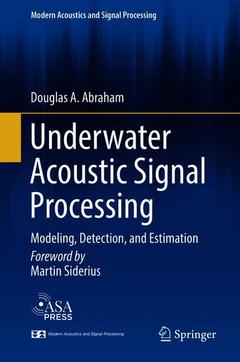Underwater Acoustic Signal Processing, 1st ed. 2019 Modeling, Detection, and Estimation Modern Acoustics and Signal Processing Series
Auteur : Abraham Douglas A.

This book provides comprehensive coverage of the detection and processing of signals in underwater acoustics. Background material on active and passive sonar systems, underwater acoustics, and statistical signal processing makes the book a self-contained and valuable resource for graduate students, researchers, and active practitioners alike. Signal detection topics span a range of common signal types including signals of known form such as active sonar or communications signals; signals of unknown form, including passive sonar and narrowband signals; and transient signals such as marine mammal vocalizations. This text, along with its companion volume on beamforming, provides a thorough treatment of underwater acoustic signal processing that speaks to its author?s broad experience in the field.
Douglas A. Abraham received B.S., M.S., and Ph.D. degrees in electrical engineering and an M.S. degree in statistics from the University of Connecticut, Storrs. He has performed basic and applied research in underwater acoustic signal processing at the Naval Undersea Warfare Center (New London, CT), the NATO SACLANT Undersea Research Centre (La Spezia, Italy), and the Applied Research Laboratory at Pennsylvania State University. He presently continues his professional and technical activities as a consultant. Dr. Abraham has also taught at the University of Connecticut as visiting faculty, and managed basic and applied research programs at the Office of Naval Research through an intergovernmental personnel assignment.
Date de parution : 03-2019
Ouvrage de 834 p.
15.5x23.5 cm
Thèmes d’Underwater Acoustic Signal Processing :
Mots-clés :
Active Sonar; Broadband Random Signals; Marine Mammal Vocalizations Signal Processing; Narrowband Random Signals; Passive Sonar; Statistics for Signal Processing; Underwater Acoustic Signals Introduction; Underwater Signal Detection Techniques; Underwater Signal Processing Book; remote sensing/photogrammetry



